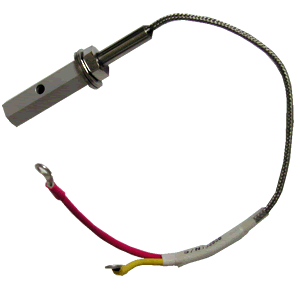 Just so we are clear, the OAT probe we refer to in this article, is the Outside Air Temperature (OAT) probe that is installed on an aircraft.
Just so we are clear, the OAT probe we refer to in this article, is the Outside Air Temperature (OAT) probe that is installed on an aircraft.
The OAT probes for aircraft are installed externally of the aircraft. The CHT Probe is not installed inside the fuselage or in the cabin air scoops; and definitely not inside the cowling. To receive an accurate air temperature reading, the OAT Probe must be installed such that the tip is outside the aircraft.
While fitting the OAT Probe, the maintenance crew need to be careful to place the probe away from any heat source and out of direct sun light. The best location therefore, is to place OAT probe under the aircraft wing but sufficiently outboard so as to avoid exhaust heat - the bottom of the fuselage would be an ideal location. For single engine aircraft installation, apart from above precautions, it would be idea to install a sun shield.
Data from the OAT probe is used in a variety of calculations such as aircraft take-off performance, flight planning, density altitude, cruise performance, and so forth.
When reading outside air temperature, there are two things to be kept in mind; one, the air temperature as the aircraft flies through it. This temperature is always a bit higher due to kinetic energy is converted to heat at the sensor and secondly; the Static Air Temperature, or SAT, i.e. the temperature of the undisturbed air through which the aircraft will fly. This temperature will always be slightly on the lower side.
The importance of OAT cannot be stressed enough. Unfortunately, most pilots tend to ignore it. OAT data is used to identify potential icing conditions and in determining such essential parameters as density altitude and true airspeed. Ideally, the OAT probe should be part of the glass cockpit package or, part of Advanced Flight Systems EFIS package or as a stand-alone gauge in a traditional cockpit.
Generally, the OAT probe has two wires (unmoulded or moulded). The power supply wire is usually red. The other wire is for transmitting the temperature data to the instrument receiving the information.
Remember that the Air Temperature Probe indicated by the OAT probe is the RAT i.e. Ram Air Temperature so called because the oncoming air as it is brought to rest and compresses at the front of the probe. To derive the actual OAT, we use the formulae SAT + (K × TAS² / 7592) = TAT.
TAT is the output from the probe. SAT is figure to be derived (in Celsius). K is the recovery factor of the probe (usually 0.8 to 0.9). TAS is True Airspeed (TAS) is in knots.
For more information, please visit: https://www.jpinstruments.com/shop/oat-probe/

